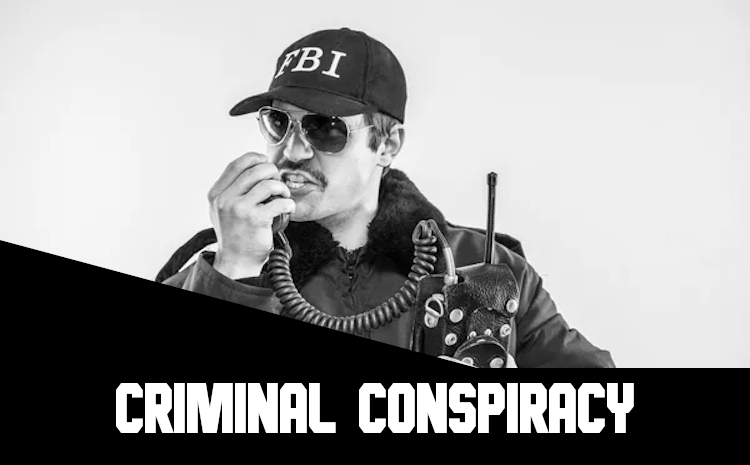DISCLAIMER: This article contains general legal information. It is not legal advice. All legal information in this article is true as of the time of writing. However, the law may change over time. To obtain legal advice about a specific legal issue that may impact your personal situation, speak to a licensed attorney. If we mention specific groups or individuals, we don’t do so to mock, shame, or disavow them. We sympathize with all political prisoners who share our worldview.
This article is part of a series that the American Futurist is releasing on legal topics that impact revolutionaries. A big problem revolutionaries face is getting into legal trouble because they don’t know the law. This project aims to alleviate this problem.
Criminal conspiracy charges are a common tactic feds use to throw political dissidents in jail. This is because unlike in the U.K. for example, there is no U.S. “domestic terrorism” law that American ZOG can use to throw members of so called “domestic terrorist groups” in jail. As a result, American ZOG uses conspiracy plots to throw people in jail.
I. Criminal Conspiracy Under U.S. federal law, criminal conspiracy occurs, “If two or more persons conspire to commit any offense…and one or more of such persons do any act to effect the object of the conspiracy…”1 In other words, a criminal conspiracy conviction requires two elements: (i) an agreement between two or more people to commit a crime, and (ii) an overt act in furtherance of that crime.2
To clarify some details regarding the “agreement” element:
• No formal agreement between conspirators is necessary to prove there was a conspiracy.3 Agreement can be implied based on circumstances, such as all parties taking concerted action with the common understanding that they are working towards achieving a common purpose.4
• It’s not necessary for conspirators to agree on the details of the conspiracy.5
• To be convicted of conspiracy, a conspirator does not have to participate in or even have knowledge of all the acts of other conspirators.6
To clarify some details regarding the “act” element:
• The “act” can be anything, including buying weapons, going to the planned location of the crime, or communicating information that enables the crime to be committed or provides knowledge about how to commit the crime.7
• The crime that is the subject of the conspiracy doesn’t have to be completed.8
• The fact that the underlying crime of the conspiracy may be impossible to achieve is no defense to conspiracy.9
◦ A common example of impossibility occurs when undercover police get their target to “conspire” to commit an act of violence. To meet the “act” element, the undercover sells the target a fake weapon, such as a bomb or gun that doesn’t work. Even though it’s impossible to commit the violence because the weapon doesn’t work, the target can still be convicted of conspiracy.10
• The act of one conspirator is sufficient to convict all other conspirators, even if the other conspirators didn’t participate in that act or agree on that particular act.11
• A single ongoing conspiracy can exist even if new members may have joined the conspiracy as time went on or old members may have dropped out.12
• The fact that some participants may have paused their criminal activity for a few months does not mean that the conspiracy has ended.13
a. Conspiracy Case Studies
• 2023 Baltimore Substation Plot: In February 2023, the founder of Atomwaffen Division (AWD) and his girlfriend were arrested for allegedly conspiring to destroy electrical substations (18 U.S.C. § 1366). The girlfriend was experiencing health issues and was told she had little time left to live. She wanted to do something worthwhile before death.
◦ The feds allege that they were communicating online with an unknown party who turned out to be an FBI informant. AWD’s founder allegedly sent information to the informant about attacking substations. He also put the informant in touch with his girlfriend. She later agreed to meet the informant to allegedly carry out the attack.
◦ Evidence obtained based on this information was enough for the pigs to get an indictment against them.
• Atomwaffen Division (AWD) Operation First Pillar: In 2020, AWD members were arrested after FBI infiltrators urged them to mail threatening posters to the houses of journalists and ADL employees in violation of 18 U.S.C. § 875(c).14 They were also charged with conspiracy.15
◦ The posters depicted hooded figures throwing Molotov cocktails at houses along with statements such as, “You have been visited by your local Nazis” and “Death to pigs.”
• “Georgia Cell” of The Base: In January 2020, members of what was dubbed by the media as the “Georgia Cell” of The Base, were arrested for conspiracy after an FBI undercover urged them to plot the murder of two Antifa members.16
◦ Despite being teenagers, the FBI undercover gave them drugs to get them to talk recklessly at a meetup. The undercover then asked them to provide details about violence they planned to commit.17
◦ Evidence against them included recordings discussing their plans and purchases of weapons that would be used to carry out the murders. The pigs later stopped their truck on their way to the Antifa members’ house before they could carry out their alleged plans.
b. Avoiding Conspiracy ChargesThe best way to avoid conspiracy is to be aware of the elements and don’t do them. Don’t agree to commit a crime with someone and don’t take any actions to further that crime. Here are some other things to consider:
• Do not join public groups. They are very easy for feds and other bad actors to infiltrate and collect evidence on group members.
• Stay out of public group chats online. Feds and other bad actors can also easily infiltrate these public group chats and collect evidence against group members.
• When communicating online, use end to end encryption. Law enforcement won’t be able to see these communications with a warrant or subpoena against the tech company. But encryption won’t help if you’re directly communicating with a fed.
• Don’t talk about committing crimes with anyone, especially not online.
• If someone were to hypothetically commit a crime, acting alone eliminates the possibility of getting arrested for conspiracy. Hypothetically, anyone who is serious about committing a crime could do it all on their own and wouldn’t need you for help.Thanks for reading and stay safe.
Hail Victory!
FOOTNOTES:
1 18 U.S.C. § 371
2 See United States v. Falcone, 311 U.S. 205, 61 S. Ct. 204, 85 L. Ed. 128, 1940 U.S. LEXIS 42 (1940)
3 See United States v. Mendez, 496 F.2d 128, 1974 U.S. App. LEXIS 8035 (5th Cir. 1974)
4 See United States v. Hearn, 496 F.2d 236, 1974 U.S. App. LEXIS 8760 (6th Cir.)
5 See United States v. Manton, 107 F.2d 834, 1938 U.S. App. LEXIS 2431 (2d Cir. 1938)
6 See A. Guckenheimer & Bros. Co. v. United States, 3 F.2d 786, 1925 U.S. App. LEXIS 3802 (3d Cir.)
7 https://www.courthousenews.com/wp-content/uploads/2023/02/sarah-beth-clendaniel-brandon-russell-criminal-complaint-.pdf
8 See United States v. Carlton, 475 F.2d 104, 1973 U.S. App. LEXIS 11042 (5th Cir.)
9 See United States v. Katz, 601 F.2d 66, 1979 U.S. App. LEXIS 14006 (2d Cir. 1979)
10 See https://archive.is/iEwQ6
11 See United States v. Socony-Vacuum Oil Co., 310 U.S. 150, 60 S. Ct. 811, 84 L. Ed. 1129, 1940 Trade Cas. (CCH) ¶ 56031, 1940
U.S. LEXIS 1050, reh’g denied, 310 U.S. 658, 60 S. Ct. 1091, 84 L. Ed. 1421, 1940 U.S. LEXIS 555 (1940)
12 See United States v. Green, 523 F.2d 229, 1975 U.S. App. LEXIS 12930 (2d Cir. 1975), cert. denied, 423 U.S. 1074, 96 S. Ct. 858, 47
L. Ed. 2d 84, 1976 U.S. LEXIS 1157 (1976)
13 See United States v. Panebianco, 543 F.2d 447, 1976 U.S. App. LEXIS 6679 (2d Cir. 1976), cert. denied, 429 U.S. 1103, 97 S. Ct.
1129, 51 L. Ed. 2d 553, 1977 U.S. LEXIS 779 (1977)
14 See United States v. Cole, 2023 U.S. App. LEXIS 8757
15 See https://archive.ph/nEQW2
16 See https://archive.ph/qReH7
17 See https://archive.ph/dQR3h

